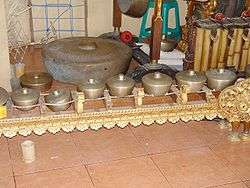Gong chime

A gong chime is a generic term for a set of small, high-pitched bossed pot gongs. The gongs are ordinarily placed in order of pitch, with the boss upward on cords held in a low wooden frame. The frames can be rectangular or circular (the latter are sometimes called "gong circles"), and may have one or two rows of gongs. They are played by one to four musicians, each using two padded sticks to strike them. They are an important instrument in a large number of Southeast Asian musical ensembles, such as Indonesian gamelan, Philippine kulintang, or Thai pi phat. For this reason, such ensembles are sometimes called "gong chime ensembles" or "gong chime orchestras," and the broad variety of music "gong chime music."
Gong chimes typically are played either in a soloistic style, providing a virtuosic embellishing role, or providing a rhythmic role, for example, in a colotomic structure.[1]
The term may also be used to refer to hand-held tuned gongs played in high rhythmic density, such as the older Balinese reyong, the Philippine gangsa, and some ensembles of minorities within the mountainous interior of Vietnam.[1]
List of gong chimes
- Source: Sibyl Marcuse. Musical Instruments: A Comprehensive Dictionary. New York: Doubleday, 1964: 213.
- Babarangan (Bali, Indonesia)
- Bonang (Java, Indonesia)
- Cồng chiêng (Vietnam)
- Cang-chen (Tibet)
- Degung (West Java, Indonesia)
- Gong hui (Thailand)
- Jengglong (West Java, Indonesia)
- Kenong (Java, Indonesia)
- Khong mon (Mon of Burma and Thailand)[2]
- Khong ñai (Laos)
- Khong noï (Laos)
- Khong wong lek (Thailand)
- Khong wong yai (Thailand)
- Kong thom (Cambodia)
- Kong toch (Cambodia)
- Gangsa (Luzon, Philippines)
- Kolintang (Sulawesi, Indonesia)
- Kulintang (Philippines)
- Kromo (Sea Dayak people of Borneo)
- Kye vaing (Burma)
- Maung saing (Burma)
- Mong (Shan State)
- Reyong (Bali)
- Talempong (Minangkabau of Sumatra, Indonesia)
- Tatabuan (Moluccas, Indonesia)
- Yunluo (China)
References
- 1 2 Ernst Heins. "Gong-chime". In L. Root, Deane. Grove Music Online. Oxford Music Online. Oxford University Press. (subscription required)
- ↑ Clark, Mitchell (2005). "Sounds of the Silk Road: Musical Instruments of Asia." Boston: Museum of Fine Arts Publications.